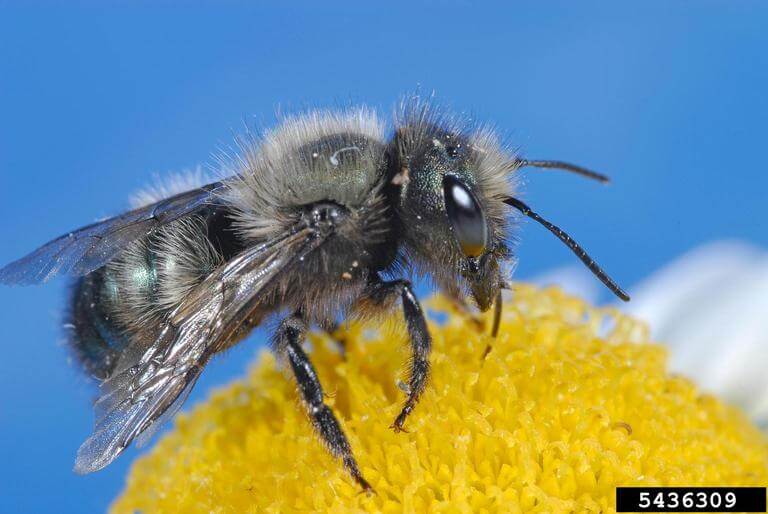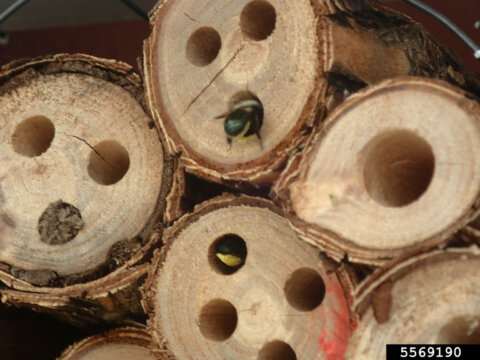
Mason bees are gentle garden pollinators. They may pollinate as many as 2,000 flowers each day. Joseph Berger, Bugwood.org.
Would you like more flowers and fruits in your yard? Think about adding mason bees. This is a great time of year to start.
Mason bees are small, gentle, solitary bees. They are non-aggressive and low maintenance. Solitary bees don’t live in a hive. All the females are fertile and there is no queen bee. Bees forage for their own food and find or create their own nests to lay their eggs. They are called mason bees because they use clayey mud to build protective walls for their cocoons. Here is a video about mason bees.
According to Rent Mason Bees, “Solitary bees make up 90% of all bee on the planet and are one of mother nature’s best pollinators! On average, each solitary bee can visit over 2,000 blooms daily and pollinate 95% of the flowers they land on.” In comparison, honeybees “only have a 5% pollination rate.”
“When you pollinate with solitary mason or leafcutter bees rather than honey bees, you’ll see significantly more fruits, veggies and flowers in your gardens,” according to Crown Bees.
How to add mason bees to your yard

Mason bees nest in tubes or hollow stems. They use mud to wall off their cocoons. Whitney Cranshaw, Colorado State University, Bugwood.org.
Gardeners can buy or rent bees for their yard, along with nesting material and bee houses.
Crown Bees sells bees, nesting material, a variety of attractive bee houses and related products. Crown Bees’ website has lots of information on mason bees to help you be successful. You may also find mason bees at local nurseries.
Rent Mason Bees sells nesting material and houses but rents the bees to gardeners. In the fall, you mail the bees back to Rent Mason Bees. The company cleans the nesting blocks and bee cocoons to eliminate pests, such as mites and Houdini flies, that threaten native bee species. The bees are then safely stored over winter.
Both companies recommend ordering your bees and related items in February or March. Mason bees pollinate fruit trees and early blooming spring plants.
Crown Bees recommends picking a shipping date that is two weeks ahead of when your first fruit tree or berry bush begins to bloom. You can store mason bee cocoons in your fridge, which keeps them sleepy until the time is right.
Choose a warm, sunny day with little wind. Hang the mason bee house on a sunny, preferably south-facing, fence or wall. The bees will hatch and fly around your yard, pollinating as they gather nectar.
It is important to have a supply of mud nearby. You can buy clay from either company if needed.
Molbak’s in Woodinville is offering a class on how to raise mason bees on February 18 from 10-11 am.
Leafcutter bees

Leafcutter bees cut the leaves and flowers of plants to make protective walls and seal their nests. Whitney Cranshaw, Colorado State University, Bugwood.org.
Leafcutter bees are also gentle solitary bees that many gardeners host in their yards later in the season. They visit many types of flowers during their flying months of July and August. Both Crown Bees and Rent Mason Bees offer leafcutter bees.
Leafcutter bees pollinate mid- to late-season garden vegetables and fruits, such as apples, tomatoes, peppers, squash, beans and peas. As their name suggests, leafcutter bees cut the leaves of plants to make protective walls and seal their nests.
Here is a video about leafcutter bees and lots of written information about identifying and raising leafcutter bees.
How to help native bees
You may have other native bees in your yard and neighborhood. You can help native bees in many ways.
Plant bee-friendly plants that are rich in pollen and nectar. Choose a variety of plants that bloom at different times, including trees that flower, so you feed different types of bees throughout the growing season.
Avoid using pesticides, especially insecticides, because they are harmful to pollinators. Use organic products and natural solutions to keep pests away.
Provide nest sites and shelter. Hollow stems, dried grasses and other materials are important habitat for native bees. Trees also provide nesting material and cavities for shelter. Bare ground is important for ground-nesting bees, so don’t cover all of your beds entirely with mulch. And don’t clear away all the garden debris when you clean up your garden.
Read our blog post on How to Help bees and other pollinators this winter for more ideas.
